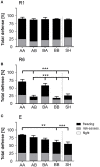Impact of Life History on Fear Memory and Extinction
- PMID: 27757077
- PMCID: PMC5047906
- DOI: 10.3389/fnbeh.2016.00185
Impact of Life History on Fear Memory and Extinction
Abstract
Behavioral profiles are strongly shaped by an individual's whole life experience. The accumulation of negative experiences over lifetime is thought to promote anxiety-like behavior in adulthood ("allostatic load hypothesis"). In contrast, the "mismatch hypothesis" of psychiatric disease suggests that high levels of anxiety-like behavior are the result of a discrepancy between early and late environment. The aim of the present study was to investigate how different life histories shape the expression of anxiety-like behavior and modulate fear memory. In addition, we aimed to clarify which of the two hypotheses can better explain the modulation of anxiety and fear. For this purpose, male mice grew up under either adverse or beneficial conditions during early phase of life. In adulthood they were further subdivided in groups that either matched or mismatched the condition experienced before, resulting in four different life histories. The main results were: (i) Early life benefit followed by late life adversity caused decreased levels of anxiety-like behavior. (ii) Accumulation of adversity throughout life history led to impaired fear extinction learning. Late life adversity as compared to late life benefit mainly affected extinction training, while early life adversity as compared to early life benefit interfered with extinction recall. Concerning anxiety-like behavior, the results do neither support the allostatic load nor the mismatch hypothesis, but rather indicate an anxiolytic effect of a mismatched early beneficial and later adverse life history. In contrast, fear memory was strongly affected by the accumulation of adverse experiences over the lifetime, therefore supporting allostatic load hypothesis. In summary, this study highlights that anxiety-like behavior and fear memory are differently affected by specific combinations of adverse or beneficial events experienced throughout life.
Keywords: allostatic load; anxiety; behavior; conditioning; fear learning; freezing; mismatch.
Figures







Similar articles
-
Varying Social Experiences in Adulthood Do Not Differentially Affect Anxiety-Like Behavior But Stress Hormone Levels.Front Behav Neurosci. 2018 Apr 24;12:72. doi: 10.3389/fnbeh.2018.00072. eCollection 2018. Front Behav Neurosci. 2018. PMID: 29740291 Free PMC article.
-
Benefits of adversity?! How life history affects the behavioral profile of mice varying in serotonin transporter genotype.Front Behav Neurosci. 2015 Mar 3;9:47. doi: 10.3389/fnbeh.2015.00047. eCollection 2015. Front Behav Neurosci. 2015. PMID: 25784864 Free PMC article.
-
The effects of early-life adversity on fear memories in adolescent rats and their persistence into adulthood.Behav Brain Res. 2014 May 1;264:161-72. doi: 10.1016/j.bbr.2014.01.040. Epub 2014 Feb 4. Behav Brain Res. 2014. PMID: 24508235
-
Early life influences on life-long patterns of behavior and health.Ment Retard Dev Disabil Res Rev. 2003;9(3):149-54. doi: 10.1002/mrdd.10074. Ment Retard Dev Disabil Res Rev. 2003. PMID: 12953293 Review.
-
The Melatonergic System in Anxiety Disorders and the Role of Melatonin in Conditional Fear.Vitam Horm. 2017;103:281-294. doi: 10.1016/bs.vh.2016.09.003. Epub 2016 Oct 31. Vitam Horm. 2017. PMID: 28061973 Review.
Cited by
-
Providing Environmental Enrichment without Altering Behavior in Male and Female Wistar Rats (Rattus norvegicus).J Am Assoc Lab Anim Sci. 2022 May 1;61(3):234-240. doi: 10.30802/AALAS-JAALAS-21-000075. Epub 2022 Apr 4. J Am Assoc Lab Anim Sci. 2022. PMID: 35379381 Free PMC article.
-
Varying Social Experiences in Adulthood Do Not Differentially Affect Anxiety-Like Behavior But Stress Hormone Levels.Front Behav Neurosci. 2018 Apr 24;12:72. doi: 10.3389/fnbeh.2018.00072. eCollection 2018. Front Behav Neurosci. 2018. PMID: 29740291 Free PMC article.
-
Early-life adversity and long-term neurobehavioral outcomes: epigenome as a bridge?Hum Genomics. 2017 Dec 16;11(1):34. doi: 10.1186/s40246-017-0129-z. Hum Genomics. 2017. PMID: 29246185 Free PMC article. Review.
-
Making translation work: Harmonizing cross-species methodology in the behavioural neuroscience of Pavlovian fear conditioning.Neurosci Biobehav Rev. 2019 Dec;107:329-345. doi: 10.1016/j.neubiorev.2019.09.020. Epub 2019 Sep 12. Neurosci Biobehav Rev. 2019. PMID: 31521698 Free PMC article. Review.
-
Impact of varying social experiences during life history on behaviour, gene expression, and vasopressin receptor gene methylation in mice.Sci Rep. 2017 Aug 18;7(1):8719. doi: 10.1038/s41598-017-09292-0. Sci Rep. 2017. PMID: 28821809 Free PMC article.
References
LinkOut - more resources
Full Text Sources
Other Literature Sources
Molecular Biology Databases

